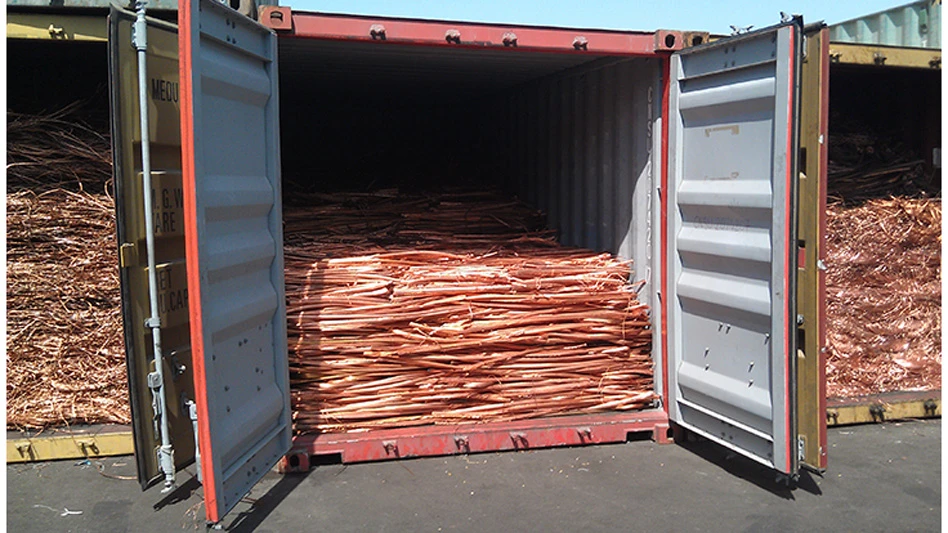Re-use, not recycling, is often the key to making money with wood from construction and demolition projects. While chipping wood for use as mulch or fuel in co-generation facilities still gives a good return on C&D lumber or timbers, reusing the wood can pay big dividends.
Demolition contractors lucky enough to be asked to tear down an old barn, factory or other classic-era industrial or agricultural building should make every effort to remove the wood carefully and to preserve it in as long lengths as possible. The construction and home remodeling market for timbers and barn-board has gone through the roof as builders strive for an authentic look for their projects.
"Our forest today is turn-of-the-century buildings," says John Williams, vice president of Mountain Lumber Co., Ruck-ersville, Va. He laments the passing of the long-leaf hard pine stands which once stretched from North Carolina to Florida and west to Texas. Such wood can only be found in old buildings.
"In the smaller dimensions, recycled wood will sell for 15 to 25 percent higher prices than new material," says Maggie Hulihan, general manager of Duluth Timber, Duluth, Minn. "Business is really moving these days."
Duluth Timber re-saws C&D wood for timbers, mantles, stair treads and other premium uses. The company sells both by the truckload to the wholesale market and to the homeowner looking for a quality product with some character.
"The recycled timber is dry, it’s seasoned and it’s not going to twist," Hulihan points out. Old timbers are pure wood, whereas it is almost impossible to find a new 30-foot length of 12-inch by 12-inch timber that has not been glued. "It really is higher quality material and we do not have a hard time selling it," she says.
However, in the larger dimensions, the market varies and recycled wood may command a lower price than new wood. Duluth Timber saws primarily Douglas fir, Southern yellow pine and some redwood. "The redwood, which comes from tanks and vats, is so dense you can’t count the rings," says Hulihan. Wood like that does not exist any more, or if it does, it is protected in National Parks. The reused redwood goes to top-end uses like gates, window frames and other showy applications.
REGIONAL VARIABLES
Wood from C&D projects is used for any number of applications. Much of it is chipped and sold for use as a fuel or as mulch, but some is reused or even made into a higher value-added product such as particle board.
"Markets for wood material are quite dependent on location," notes Michael Taylor, executive director of the National Association of Demolition Contractors, Doylestown, Pa. In the Philadelphia area, for example, Delaware Valley Recycling used to sell wood chips for use as a drying agent for sewage sludge at processing plants located near the Philadelphia airport.
In the western United States, much of the material generated is used as power plant fuel. "Those operations tend to be smaller-size generators, providing power to the agricultural areas," Taylor says.
"We see the day coming soon when the market will move away from products heavy in the chip and mulch area," says Cinda Jones, director of marketing, American Forest & Paper Association, Washington, D.C. One product she predicts will become popular is OSB – oriented strand board. Now produced primarily in Germany, it is a plywood replacement similar to particle board.
Instead of sawdust flakes, OSB uses wood chips positioned at angles to one another. "As the first production companies get the technology, we want the fiber supply base to be ready," she says.
But again, a great deal of wood is reused as opposed to being transformed into other products. In fact, it is here that a recycler can often turn the best profit on a wooden structure. "Anything beyond pine has value," says Taylor. "Oak, ash and walnut all are in demand in Europe."
Mountain Lumber is not having any problem selling what it produces, according to Tricia Belan, marketing director. "We are barely able to keep production up with sales," she says. The company turns materials into three-quarter inch flooring, half-inch paneling, and mill products like stair treads, posts, molding and mantelpieces.
With a buyer in Illinois, Mountain Lumber covers much of the East, Southeast and Midwest, buying several million board feet of reclaimed timbers each year.
"Buyers must be willing to travel at a moment’s notice to some of the worst places in the nicest cities in the U.S.," says buyer John Williams. "Variables such as size of the timber, grain density, knot content, sapwood content, bolt holes, shake and other damage, contamination, infestation, rot, warp, twist and many others are all considerations."
The buyer also has to interview the dismantling contractor to determine the method of demolition. "I can’t begin to tell you how many times we’ve closed a deal on exceptional material only to have an over-zealous crane operator reduce a magnificent looking timber into a pile of splinters," Williams says.
In Southern California, much of the wood from demolition jobs is reprocessed in Mexico. There, the wood material is cleaned up and nails, bolts and other hardware are removed. The boards then are used in new construction projects. However, there is a large export market beyond Mexico, especially in Europe where timber is not as plentiful as it is in North America.
Material is always run through a metal detector before being put on the saw. The detectors usually catch anything the crew missed, but from time to time a deeply embedded nail turns up.
The grandfather of all wood reclamation projects was the old Sears Catalog Center on the South Side of Chicago. Brandenburg Industrial Services Co., Chicago, demolished the building, which was mainly brick and wood. Bill Moore, marketing director for Brandenburg, maintains there was no way they could have torn down the building for the scrap metal value. "Not unless the building was all aluminum or copper," he says.
But the wood was recovered, according to Moore. The antique pine boards were sold to Spain for flooring. The decking, timbers and the 4-by-6’s were sold for tongue-and-groove planking. The remainder of the building, mainly 1-by-3 maple, was ground and landfilled. Here the regional differences are pronounced. "We could not find a market for it," Moore says. "On the East Coast or up in Wisconsin we could have sold it for boiler fuel. But not here."
Dealing with contractors is the most direct method of moving the material. On occasion, C&D timbers can be removed from the site to a construction location. For those not active in the business, often a simple classified advertisement in a local paper will bring buyers out of the woodwork. Because such wood takes years to produce and mellow, its worth goes far beyond its board-foot value.
"Wood roofing generally can be recycled," according to Patty Wood-Shields, consultant for the Cedar Shake & Shingle Bureau, Bellevue, Wash. "That does not apply to fire-retardant treated materials, however."
About 75 percent of the wood on buildings today is in its natural state, she continues. Treated wood occupies less than 25 percent of the market.
CSSB has done extensive testing on the insulating merits and comparisons of production costs for recycled vs. virgin materials, as well as work on recycling itself. The cedar tow (chips) have been used to manufacture a "fake shake," Wood-Shields explains. The chips were mixed with perolite to produce a fire-retardant shake. However, this turned out not to be a cost-effective product.
|
NOSTALGIA FOR OLD WOOD |
|
Talking to a C&D wood buyer is like talking to an antique car buff. No red-blooded scrap dealer would think of sending a ’64 Mustang or a ’56 T-bird to the crusher. Timber buyers look at old buildings the same way. There is reverence in their voices as they talk about finding a 12 x 17-inch beam that’s 30-feet long, and totally lacking any hint of the center heartwood – imagine how big the tree had to be. There is grudging respect as they talk about redwood so dense it dulls their bandsaws in a jiffy. This is the same respect two heavyweight fighters give one another after a tough 15-rounder. They see the environment as it once was: valuable timber stands across the Southern forest and up the Pacific Coast now are harvested only from the C&D projects they find. Today’s yellow pine is a meaningless term. It’s the long leaf hard pine that they seek out. Foresters can’t wait 400 years to grow a straight, five-foot diameter tree that’s 160 feet tall. Buyers have a bit of missionary zeal, striving to find the unrecognized value in real estate and convert it into product for today’s market. There’s a rush in their voice as they describe their victories and sadness as they relate defeats. As they speak, one can see their eyes caressing the color of a refinished beam, savor-ing the wood textures. Their reward is restoring the past, bringing it forward to a new 100-year life. |
CHIPPING CLIPPINGS
Wood waste from cedar shake and shingle often is sold for landscaping bark or is used to make pet beds, essentially sacks full of cedar chippings.
James Brooks, president of Woodchuckers, San Jose, Calif., takes shake and shingle roofing material with its felt paper. "We separate the paper from the shakes and grind them to the size of a quarter for use in co-generating boilers," he says. Most of the material he sees is redwood. Material in good condition is set aside and either made into planter boxes or is sold directly, mainly to the home market for people building sheds, dog houses and the like. "Anything over four feet we resell," he says. "There is a good market for three-quarter inch plywood."
In the Santa Cruz area, he adds, there is a market for bedding chips used in horse stalls.
In Detroit, a project is underway to quantify and document the amount of C&D material which can be diverted from landfills. The proposal is being handled by Bonnie Maurer, project manager for the Michigan Dept. of Natural Resources, and run by a group called the Cass Corridor Neighborhood Development Corp. with The Christman Co. The project aims to divert 100 percent of structural materials and 75 percent of demolition material, including glass, steel, concrete, wood, drywall, carpet, paper, plastic and other materials.
The Cass Corridor team has identified sources for interior and exterior doors, millwork, lumber and other fixtures. The Christman Co. says its research "clearly shows that new construction is likely to continue to decline over the next decade, while renovation, restoration, and adaptive re-use of the existing building stock will continue to grow from its 1990 level of approximately $75 billion annually for the country as a whole."
Dinverno Commercial Rubbish Removal has been retained to collect recyclables for the project, and all material from the project will be weighed to compare the ratio of recycled to non-recycled materials.
While state rules for C&D waste vary, in most states they are similar to those in Michigan. Seth Phillips, acting chief of the Solid Waste alternatives program for Michigan’s Department of Environmental Quality, says that recycling of C&D debris is regulated like any other solid waste material. "State law allows some materials to be separated and recycled. Under certain conditions, that material can be exempt from the solid waste laws," he says.
GET THE LEAD OUT
Wood is generally exempted from solid waste laws if it is not contaminated, either with paint or preservation materials. Drywall, on the other hand, is not specifically exempt. People can come up with proposals for recycling the material and they are considered on a case-by-case basis, Phillips adds.
"We check every load for lead paint," says Belan. Loads with lead are stored for processing all at one time. They also test the sawmill dust weekly. "We try to analyze the situation on-site before we make a decision to buy, especially if they suspect chemicals may have been present in the building where the salvage operation is being conducted," he says.
One of the next big sources for C&D material is going to be military bases. Here, however, there is going to be a serious problem with lead-based paint on the wood. Regulators, demolition experts and wood processors all agree that unless a way is found to deal with lead in paint there is going to be a lot of otherwise-valuable material landfilled.
Lead is not the only material associated with wood that presents problems for recycling and reuse. Treated materials generally are avoided by buyers in the market.
Another factor slowing the progress of wood recycling or value-added processing of all types of recycled wood is the timber industry’s long-held pride in being the one industrial resource that is indefinitely renewable. There is a strong commercial propensity to producing virgin materials.
In addition, wood is biodegradable. When wood is no longer usable, it can be readily absorbed back into the earth with no environmental harm. Wood fibers turn into non-toxic dirt and enrich the soil as they decompose. On a building site, wood scrap can be chipped and composted immediately with no hauling and no landfilling.
"Wood waste is not a serious problem in the U.S. and accounts for only seven percent of landfill space by volume," according to the CSSB. "Old wood roofing and siding can be easily disposed of without worrying about toxic chemicals leaching into our drinking water and poisoning the earth."
"Recycling is an answer to diminishing natural resources but it is not the panacea we would all like it to be," says the Canadian Wood Council. They point out that each time a product is recycled it is degraded and so a product can not be recycled forever.
NEW USES
A study currently underway in Wisconsin, conducted by Gershman, Brickner & Bratton Inc., Falls Church, Va., may lead the way into allowing wood from C&D debris to be made into a higher value-added product such as reconstituted panelboard. According to Robert Brickner, senior vice president of GBB, the study is funded by a grant from the University of Wisconsin Solid Waste Recovery Research Program.
"We are looking at wood waste sources from C&D, construction, urban woodlands, manufacturing waste and pallet waste," he says.
The project, which should be completed in late summer, will research the availability and economics of using wood waste materials generated in the Milwaukee-Madison-Oshkosh triangle of Southeast Wisconsin. Working with Cornerstone of Wisconsin, Inc., McHenry, Ill., the research will look at the economics of developing a reconstituted panelboard manufacturing plant. The research will analyze the specifics of wood generation, collection, and sorting; panelboard production; and regional marketing of the end product.
One of the keys to success, Brickner says, is getting construction wood out of the mixed waste stream and making sure it is not contaminated with materials such as lead-based paint.
But regardless of exactly what use the material ends up in, interest is so strong in reusing and recycling wood that the AFPA has produced a booklet listing manufacturers, lumber suppliers, building contractors and C&D specialists. "We get literally a dozen calls a week," Jones says.
The author is an environmental writer based in Strongsville, Ohio.

Explore the March 1996 Issue
Check out more from this issue and find your next story to read.
Latest from Recycling Today
- USTR announces phased measures designed to address China’s shipbuilding dominance
- APR, RecyClass release partnership progress report
- Clearpoint Recycling, Enviroo sign PET supply contract
- Invista expanding ISCC Plus certification program
- Redwood partnership targets recycling of medium-format batteries
- Enfinite forms Hazardous & Specialty Waste Management Council
- Combined DRS, EPR legislation introduced in Rhode Island
- Eureka Recycling starts up newly upgraded MRF





